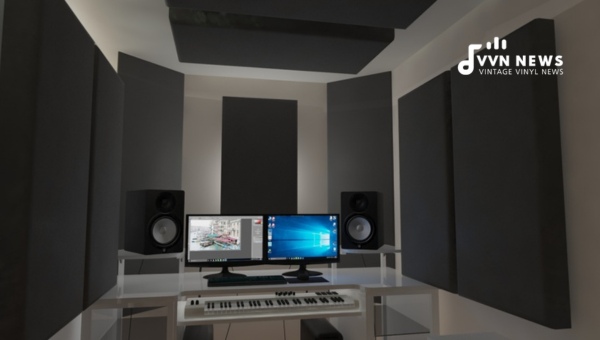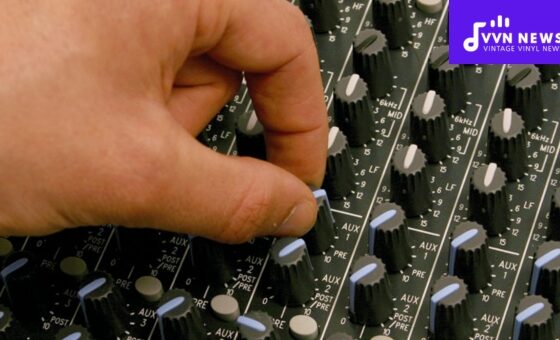Has it ever occurred to you how sound behaves inside a room? If so, you’re on the right track to understanding the need for acoustic treatment.
The acoustic treatment guide for panels and foam offers a fascinating insight into the science behind tranquil listening environments and improved sound quality, whether for your music studio, home theatre, or office space.
How often have we been in a room that resonates with echo or one that seems to consume the audio, leaving it lifeless and flat? It’s annoying, right?
Well, fret no more! You’re going to master this challenge. You can transform any place into an aural paradise by implementing some fundamental knowledge regarding acoustic treatment panels and foam.
Keep reading this acoustic treatment guide for panels & foam, and get ready to change your audio world!
What is Acoustic Treatment?

Acoustic treatment refers to improving the sound quality within a room or space by reducing unwanted echoes, reverberation, and background noise.
This is achieved by strategically placing sound-absorbing materials such as acoustic panels, bass traps, diffusers, and soundproofing materials.
By using acoustic treatment, the reflections of sound waves are managed, resulting in better speech intelligibility, reduced sound distortion, and an overall more balanced and pleasant listening experience.
It is commonly applied in recording studios, home theaters, conference rooms, auditoriums, and other environments where accurate sound reproduction is desired.
The specific approach to acoustic treatment may vary depending on the characteristics of the space and the intended use.
Factors such as room dimensions, surfaces, furniture, and materials can affect the acoustics of a space.
By understanding these factors and applying appropriate treatment techniques, it is possible to create an optimized acoustic environment that enhances the clarity and quality of sound.
Also Read: B Flat Minor Pentatonic Scale [Create Emotive Music In Minutes]
Types of Acoustic Treatment
Understanding the differing types of acoustic treatments is crucial for any successful sound improvement project.
Let’s dig into some core categories that you’re likely to encounter.
Absorption
This is the process used to manage unwanted reflections in your audio space. The primary tools for this job are absorption panels or bass traps.
These foam materials target mid-to-high frequency sounds, effectively soaking them up and stopping them from bouncing all over your space.
It’s worth noting that a well-designed room will primarily use absorptive surfaces to control reflections.
Coupling/Decoupling
This technique is often utilized in treating low-frequency sounds or bass, which tend to couple (unite) with surfaces similar to their wavelength, inevitably producing a room-thumping sensation.
Decoupling methods prevent the propagation of these low frequencies by physically isolating structures like speakers from surfaces they come in contact with.
This could be achieved with both mass-loading and mechanical isolation methods, damping floor vibrations that may muddle your audio.
Reflection/Diffusion
Think of diffusers as echo destroyers. They work by scattering sound waves randomly instead of allowing them to bounce off surfaces straight back at you—an effect called ‘flutter echo.’
Diffusers enable us to retain lively-sounding spaces without the harsh echo of untreated rooms.
One important notion is knowing when and where to use each type of treatment.
An overly treated room can leave it feeling unresponsive or lifeless, while an under-treated one can sound disorderly due to uncontrolled reflections.
Striking the right balance requires some skill and science – but don’t worry! Practicality guides most choices.
So there you have it—Absorption, Coupling/Decoupling, and Diffusion form a trident – each prong working together to help shape your sonic paradise.
Also Read: F Music Note [Unlock The Secrets Of The Musical Alphabet]
Benefits of Acoustic Treatment

Implementing acoustic treatment in your space can significantly change the quality of sound and overall listening experience. Here are some key benefits:
Enhanced Speech Intelligibility
Often, speech intelligibility is compromised in untreated spaces, especially those with high ceilings or hard surfaces.
With the proper acoustic treatment, listeners can hear spoken words distinctly without any mix-up of sounds or intrusive echoes.
This is excellent news for those setting up a home office or students engaged in online learning.
Improved Sound Quality For Audio/Video Experiences
Whether you’re watching movies, listening to music, or gaming, proper acoustic treatment can significantly contribute to an immersive experience by improving the sound quality. No more annoying echo nor sound warbling!
Ideal for Recording Studios
It might seem like a no-brainer, but musicians and producers would know. By controlling unwanted reflections and achieving a balance of sounds through acoustic panels, your recording sound becomes much cleaner, resulting in higher-quality outputs.
Also Read: Aeolian Mode [The Secret To Creating Moody & Expressive Music]
Reduces Stress & Enhances Productivity
Did you know that unpredictable, noisy environments could increase stress levels?
Additionally, it could hamper our productivity by causing disruptions and distractions.
However, implementing acoustic treatment can control these noises, paving the way for a less stressed-more productive you!
The acoustic treatment required may vary depending on factors like room size, type of sound used (Speech/Music), the materials already in the room, etc.
Tailoring your space per your specific requirements could be rewarding by enhancing your overall sonic experience!
Different Types of Acoustic Panels and Foams
When it comes to acoustic treatment, we’ve seen it primarily involves the use of acoustic panels and foams.
But did you know that these tools have several types, each serving a unique purpose?
Absorption Panels
Absorption panels are typically made from porous materials that trap and convert sound energy into heat energy.
They are handy for controlling mid to high-frequency sounds, helping to eliminate echo and reducing the overall sound level in a room.
Different thicknesses are available for these panels; the thicker the board, the lower the frequency it can absorb.
Basstrap Panels
Basstrap panels come into play when there’s unwanted bass or low-frequency noise. These are usually placed in corners where bass tends to build up.
Like absorption panels, bass traps also convert sound energy into heat, but they’re specially structured to capture those stubborn lower frequencies.
Diffusion Panels
Unlike absorbers, diffusion panels scatter the sound waves around the room instead of absorbing them.
It extends the horizontal sound dispersion, making your room’s acoustics richer and fuller. These work best with high-frequency sounds.
Soundproofing Foams
Soundproofing foams, known as Acoustic Foams, help reduce echo while smoothing sharp or discordant noises in your enclosed spaces.
They help decrease surface reflection and increase air resistance, significantly reducing noise levels.
Choosing between these options depends on your unique needs – nature of the sound issue, room shape/size/materials, etc., and understanding what each type brings to the table is critical for matching them with their appropriate application.
Also Read: G Major Scales And Chords [Expand Your Musical Understandings]
Where to Place Acoustic Panels and Foam for Maximum Effectiveness?

Whether you have a professional recording studio or a simple home theater setup, strategically placing your acoustic panels and foam can determine the quality of sound you experience.
Incorrect placement may result in poor acoustic treatment, while properly positioned panels and foams improve sound clarity and comfort.
Identifying Reflection Points
Your first task is to identify the critical reflection points in the room. These points, where most direct sounds bounce off, typically include walls directly opposite speakers or any side wall near speakers and the ceiling.
A tried-and-tested trick is to use a mirror: Sit at your listening spot (like where you’d be playing an instrument or sitting to watch a movie) and have someone move a mirror along the wall.
If you see the speaker in it, mark this spot – it’s a primary reflection point!
Early Reflections Vs Late Reflections.
Early reflections are those that reach our ears shortly after the direct sound. Treating these is generally very critical for clarity.
Late reviews, given they arrive late to our ears, contribute more to space’s ‘liveness’ or ‘ambiance’.
A couple of panels at late reflection points (back wall when monitors face front wall) could create interestingly cozy audio spaces.
The Corners
Corners are often overlooked, but they are essential! They can serve as bass traps, helping you control lows due to their mode of accumulating low-frequency build-ups over time.
Ceiling Matters
Yes! The ceiling forms an integral part of room acoustics, with it being another primary reflective surface.
Each room has different acoustic properties depending on its size, shape, and furnishings.
You’d likely have to try and test different positions before you find just the right spots that improve your audio quality dramatically!
Step-by-Step Guide on Installing Acoustic Panels and Foam
Installing acoustic panels and foam might seem like a challenging task, but with some guidance, it’s a project you can effectively complete yourself.
Here are step-by-step instructions to help you through the process:
Identify the Reflection Points
Start by identifying your room’s ‘reflection points’ or ‘mirror points.’ These are spots where sound waves tend to bounce off the most.
You can detect these using an actual mirror; place the mirror flat on the wall and have someone slide it around while you sit in your listening spot.
When you see a speaker’s reflection in the mirror, mark that point – it’s your first reflection point.
Measure Your Wall Space
Measure your wall space to determine your needed panels or foam squares. Consider more comprehensive coverage for rooms with more echo.
Gather Materials
Purchase acoustic panels or foam along with the necessary installation tools and materials like adhesive strips, mounting brackets, or impaling clips, depending on what type of panels you are installing.
Some hard-to-find tools that you might need include:
- Level: This tool will help ensure your panels are straight.
- Stud finder: It’s helpful if you’re screwing brackets into walls.
- Tape measure: Necessary for precise placement of panels.
Also Read: D Major: The Scales And Chords [Broaden Your Musical Vocabulary]
Preparing Acoustic Panels and Foam
If your acoustic foam arrives vacuum-packed, give it enough time to expand back to its original size. It could take up to 24-48 hours.
Installation
Begin installation by applying adhesive at the back of each panel (if necessary) and position them accurately at each marked point while ensuring they are level with each other if installed periodically.
If using mounting hardware, ensure they’re mounted securely onto the studs.
And that’s all there is to it! The whole process can be finished in an afternoon, and the results are worth the effort.
It’s important to note that acoustic treatment requires experimentation, so don’t hesitate to adjust your panels’ positioning over time to see what gives you the best sound.
Common Acoustic Issues
Understanding common acoustic issues is the first step toward improving your sound environment.
Typical problems include comb filtering, flutter echo, room modes, and decay time.
Comb Filter
A comb filter effect happens when a sound source produces the same frequency at slightly different times, resulting in constructive (boost) and destructive (cut) interference.
These fluctuations produce an output that resembles a comb’s teeth on a frequency response graph (thus the name).
You might notice this as a hollow or “phase” sound when listening to audio in your room. Using diffusers or absorbers can mitigate comb filtering.
Flutter Echo
Flutter echo occurs when a sound repeatedly bounces back and forth between two parallel surfaces, causing a rapid series of echoes.
Imagine clapping your hands inside an empty stairwell; you will likely hear an ongoing series of rapid-fire echoes – that’s Flutter echo for you!
Placement of acoustic foam on these surfaces can disrupt the path and significantly reduce flutter echo.
Room Modes
Room modes, or standing waves, are another common acoustic concern. They occur when specific frequencies become amplified due to matching the architectural resonance within a space.
This results in some frequencies sounding abnormally loud while others may seem weak or non-existent.
To control room modes, it’s crucial to understand where they exist by mapping your room’s resonant frequencies and making appropriate adjustments with bass traps or other absorption materials.
Decay Time
Last but not least is decay time – it’s all about how long sound can fade away in a given space after its initial production.
In layman’s terms, how long that guitar strum lingers in the air before it feels silent.
If this fade-out too fast, the space may seem lifeless and dull; if slow, it could cause muddiness as sounds bleed into each other, making individual notes or instructions indistinct.
Balancing decay time can be achieved through a series of absorption, diffusion, and sometimes reflection treatments.
All these might seem a little technical, but the stark reality is – acoustic excellence cannot be achieved without addressing these common acoustic concerns.
Fixing these primary sound emittance issues can drastically improve your overall audio experience.
Be assured that with this Acoustic Treatment Guide for Panels & Foam guidance, you’ll have the upper hand in solving your room’s acoustic quirks.
Additional Resources for Further Information on Acoustic Treatment

If you’ve made it here in this guide, your journey through the realm of acoustic treatment has likely just begun.
And what better way to ensure a strong standing than hitting up additional resources?
While resorting to a professional acoustician is always a good idea, there’s no harm in self-educating. After all, knowledge is power!
- Acoustic Design Websites: Websites like GIK Acoustics and Primacoustic provide extensive information on various acoustic design principles, along with product guides.
- Books: One of the best ways to understand the science behind sound and acoustics is by reading relevant books. The famous book “Master Handbook of Acoustics” by F. Alton Everest does an exceptional job of breaking down complex acoustic theories.
- Online Forums: You can always ask for help or browse discussions in forums related to acoustics, such as Gearslutz. These platforms usually host a mix of experts and amateur enthusiasts who share their experiences and knowledge.
- YouTube Channels: Several YouTube channels dedicated to audio technology and room acoustics, such as Home Studio Corner by Joe Gilder or PS Audio, provide very informative content on the concept.
- Podcasts: If you’re more into listening than reading, then podcasts like Sound Matters or Twenty Thousand Hertz deliver unique insights into the science of sound and acoustics.
This rabbit hole goes deep! The more you dive into it, the more fascinating it becomes; transforming any room or space to deliver the best possible audio experience.
Also Read: A Major Scale [The Key To Bright, Cheerful Musical Pieces]
FAQs About Acoustic Treatment
What is bass trapping in acoustic treatment?
Bass trapping is a technique used in acoustic treatment to control and absorb low-frequency sounds, often using specifically designed panels or foam to prevent these sounds from bouncing around the room and causing reverberation.
How much does professional acoustic treatment cost?
The cost of professional acoustic treatment varies greatly based on the size of your space and the materials used, but it can often range between $500 to $2000 for small to medium rooms.
Do I need acoustic treatment if I just use headphones?
Though headphones can bypass room acoustics, having a well-treated room can enhance your overall audio experience for speakers and provide a balanced, natural sound.
Can regular household items work as effective acoustic treatment?
While certain household materials like heavy curtains may reduce some echo, they lack the specificity in controlling frequencies that dedicated acoustic panels and foams offer.
Are foam panels better than diffusers for acoustic treatments?
Foam panels and diffusers serve different purposes; while foam helps absorb sound energy reducing echo, diffusers disperse sound waves evenly across the room preventing hotspots or dead zones. Both are necessary for holistic room acoustics improvement.
Conclusion
Getting acoustic treatment right is truly an art. Understanding the concept is one thing, but applying it takes practice and patience.
It’s about finding the right combination of absorption, coupling/decoupling, and reflection/diffusion to create the perfect sonic environment.
Remember to focus on problematic frequencies and areas within your room using an online room mode calculator.
Do not forget that the process is iterative. Begin with small changes, monitor the results, and adjust accordingly.
Undoubtedly, this will enhance your overall audio experience by curbing unwanted noise and creating a more focused sound field.
Be patient, and attentive, and eventually, you’ll build yourself an exquisite listening space!








